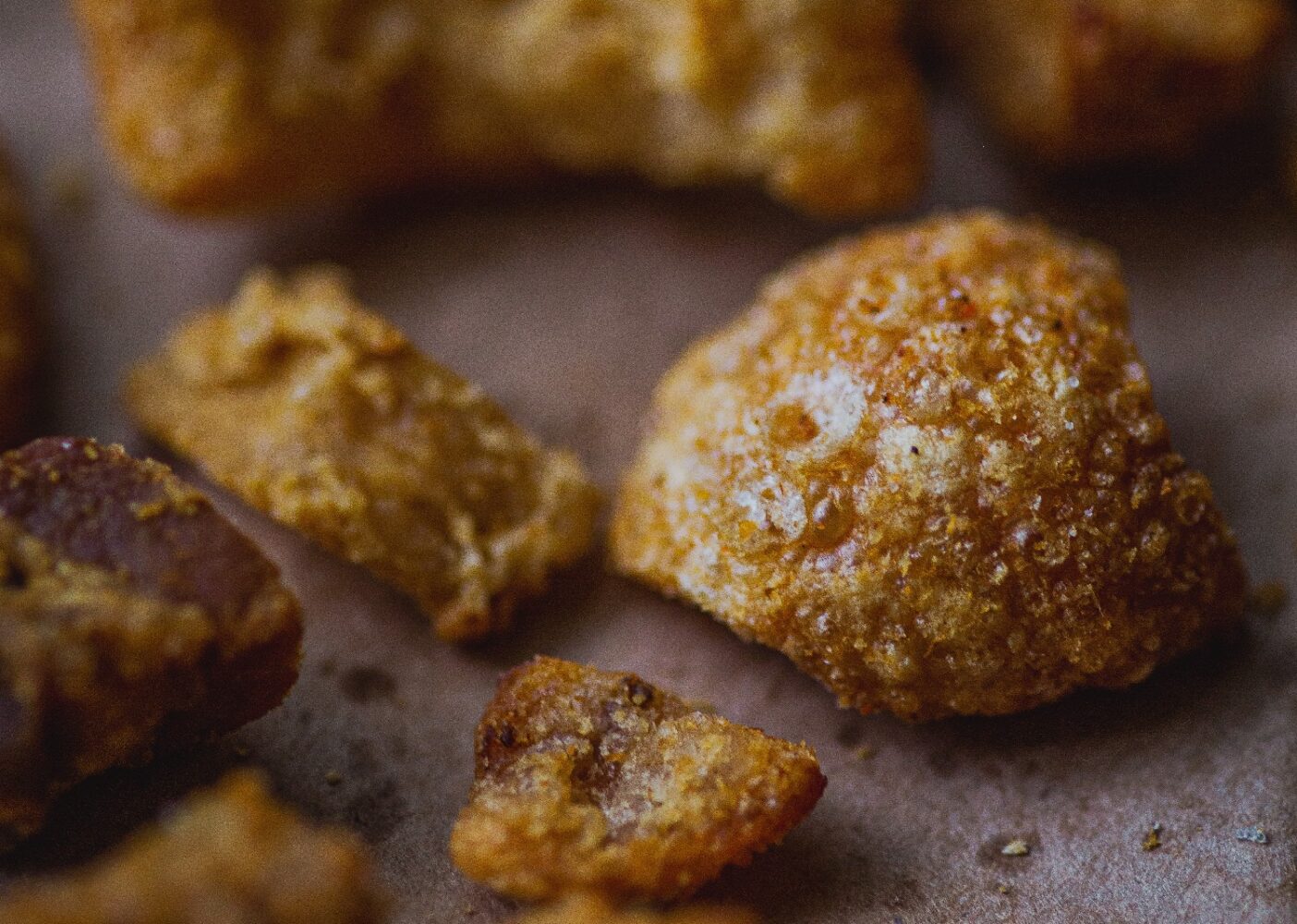Cracklin’ Hound
The delights of fried pork skin
Published: August 30, 2022
Last Updated: May 11, 2023

Photo by Lucie Monk Carter
I shared with them my first memory of cracklins. My Uncle Jim produced a bag of crispy, salty, piggy treats with the Spanish name of chicharrón, which we promptly baptized “chick-a-roons.” I would occasionally pick up a bag in a corner deli from time to time, never knowing that they were but the gateway to the real cracklins that I would meet later in life.
Today I am the cracklin equivalent of a truffle hound, able to snuffle them out in places both likely and obscure. I always come home with greasy brown paper sacks from JazzFest, where the cracklin booth is usually my first stop. I’ve located compound buckets full of them under the counter at Poché’s restaurant in Breaux Bridge, and I’ve found them in one gas station stop along I-10 on the way to Washington, Louisiana. But as a non-driver, my access to these sources requires not only a road trip but also a willing chauffeur. So I have now focused my quest for cracklins within the New Orleans area, where the search is less taxing on my friends’ patience and indulgence. I’ve been successful. There’s the Cajun grocery store, Chris’ Specialty Foods on West End Boulevard in New Orleans, where I get them alongside plastic bags full of frozen Cajun gumbo with a magnificent mahogany roux. They also sell, for pre-order only, cracklin debris—frying up the small bits leftover after preparation—which is perfect for topping salads and vegetable dishes and adding a little crunch, and a little pig. Most recently, I found cracklins at Danny & Bonnie Seafood on Belle Chasse Highway. They fry it up and sell it warm and greasy straight out of the big kettles. I bought two pounds worth and watched with delight as the brown paper bag turned translucent with pig fat.
Over the years, I have learned that the crunchy pork snacks my uncle introduced me to years ago were not cracklins, but rather pork rinds: crisped pork skin. Cracklins have not only the skin, but also bits of attached pig meat. They are seasoned in a spice mix that is proprietary to the vendor; some are spicy, while others may be salty, peppery, or a savory mix redolent with unidentifiable spices. I love ‘em all. Once traditionally prepared only at cool-weather hog butchering time—a special treat from a boucherie—cracklins are now available almost all year round.
Cracklins are street eats, a snack that has no pretentions. They can, though, get dressed up and go to the ball—as when antiquaire Patrick Dunne occasionally serves them to his clients at his culinary antique emporium Decorations Lucullus, accompanied by fine French champagne. The pairing is a revelation: the crisp bubbles nicely counterbalance the porcine delight of the cracklins. He crisps them up in a cast-iron skillet prior to serving them on eighteenth-century china.
I am not as generous and don’t always share mine. After all, they’re precious, and I don’t get them as often as I’d like. However, I’ve got some secret suppliers. My friend Amanda McFillen, whose parents live in Cajun country, is kind enough to ask her parents for care packages for me, and they bring the goods whenever they come to visit. Amanda is such a good friend that she has even taken to shipping them to me when I’m out of state, so that I periodically receive a post-office package with a telltale smear of grease.
I haven’t yet attended, but the Port Barre Cracklin Festival in November is on my horizon. It has all of the usual features of Louisiana community festivals: a Queen’s Pageant, a parade down Main Street, carnival rides, live music, great food, drinks, and of course, a cracklin cook-off. In Parks, Louisiana, there’s a cracklin cook-off in April, and the Louisiana Swine Festival celebrates all things pig in Basile in November. I suspect I could make a pretty good haul at any of them and also learn more about the tasty bites that have become one of my culinary obsessions. My cardiologist may object.
Jessica B. Harris is the author, editor, or translator of eighteen books, including twelve cookbooks documenting the foods and foodways of the African Diaspora. She lectures and consults widely in the United States and abroad and has written extensively for scholarly and popular publications. Recently retired from Queens College/CUNY, Harris is the recipient of numerous awards for her work, including the 2020 James Beard Lifetime Achievement Award. In 2021, she was listed as one of TIME Magazine’s 100 most influential people. This year, the Netflix documentary series High on the Hog, based on her book of the same name, won NAACP Image and Peabody Awards.
